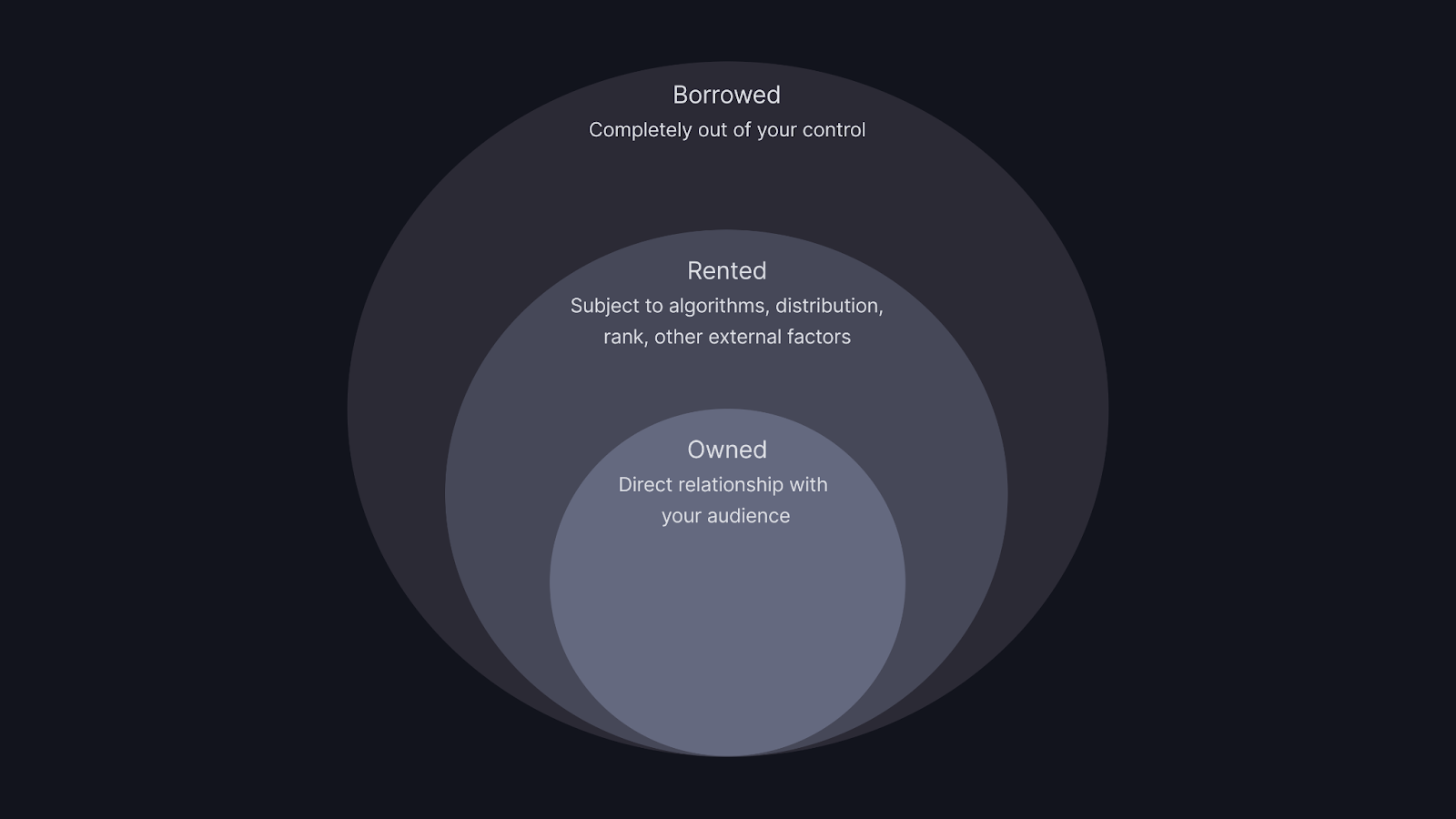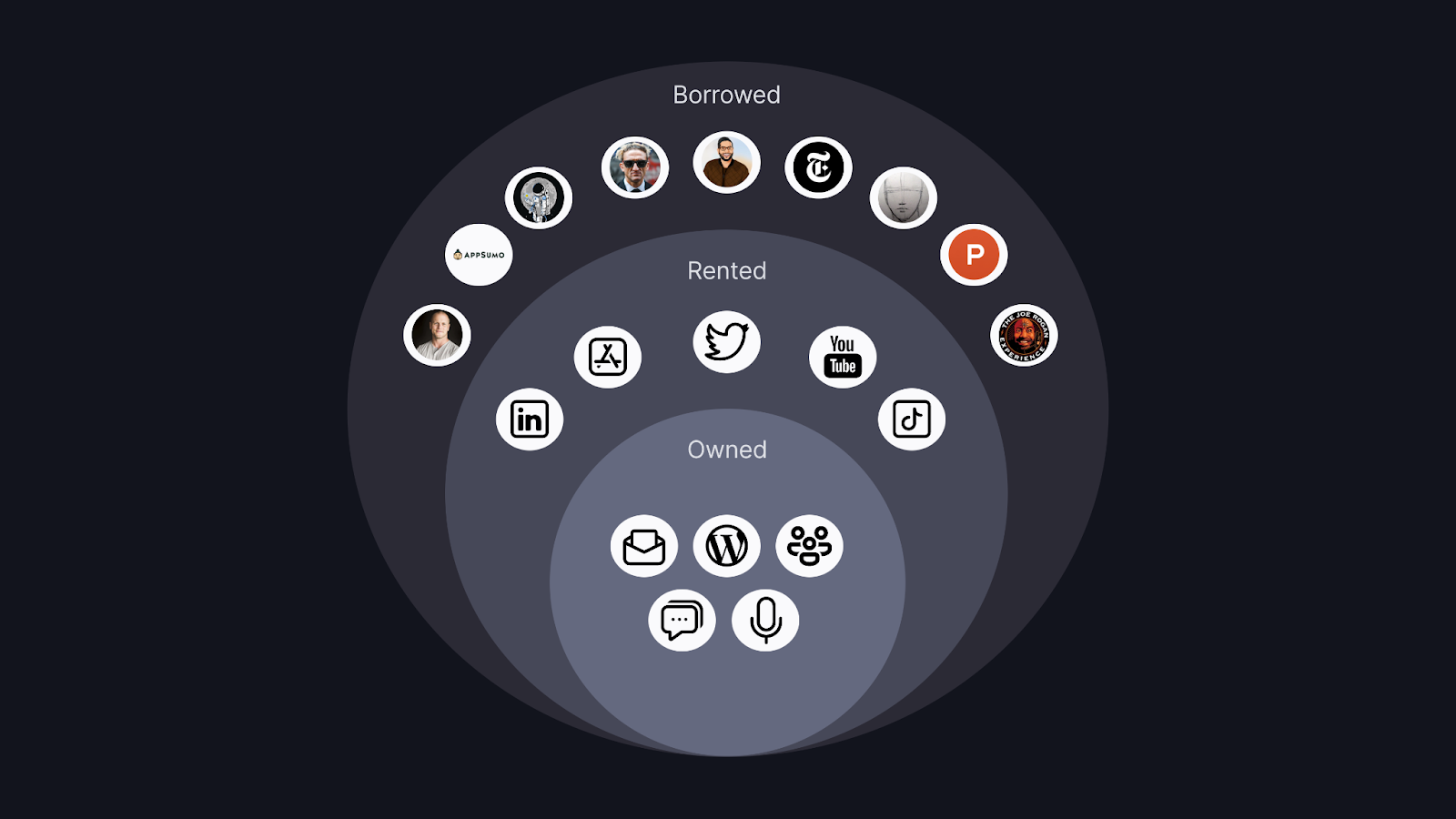
The ORB Framework: A New Way To Think About Marketing Strategy

Whether you're sitting down for the first time to create a marketing strategy for your new app or brainstorming where to allocate $1 million in additional budget this year, you'll have to wade through the plethora of strategies and tactics available today.
Newsletter referral program, editorial blog posts, programmatic SEO, PR stunts, engineering-as-marketing, TikTok, Whitelisted Influencer marketing, Twitter threads... the list goes on and on and on.
I've found that marketing strategies and tactics can be broken down into three main categories: Owned, Rented, and Borrowed. In other words, you have lines of communications to an audience that you either own, rent, or borrow.
All are viable ways to reach your intended audience and have their place in the overarching marketing plan.
When you look at those three categories together, you get a handy framework to create a winning marketing plan. Here’s what the ORB Framework is and how you can use it for any business or marketing campaign.
The ORB Framework looks like this:

The concentric circles are meant to represent the level of depth you have with the audience. At the core, you’re as close to your audience as you can be. It’s a private medium. As you expand outward, you reach more people, but the level of depth and connection is reduced.
When you lay out all your marketing experiments and channels, everything should point back to your owned platforms. Borrowing someone else’s audience is all for naught if you can’t lead them back to a rented or owned platform. Rented platforms, especially, should be used to lead your audience back to an owned platform to reduce the risk of lost reach or access that rented platforms are prone to.
At the end of this exercise, you should be able to map out something that looks like this:

Once you lay everything out, you can see which owned platforms you’re going to invest in, where you’ll engage your audience to grow those owned platforms, and how you’ll grow your audience by borrowing other people’s audience.
Don’t worry if it looks fairly simplistic. It doesn’t have to be complex!
Let's break down each circle individually.
Owned

It's important to note that you don't own your audience, you own your platform.
You own the line of communication.
More control, more reach, and more predictability. Naturally, owned platforms get more effective over time whereas borrowed and rented platforms usually get less effective over time.
Ask any successful creator or brand what their most successful marketing channel is and they'll probably name one of the owned platforms: blog, email, community, podcast, or text message list.
So which of the owned platforms should you invest in? Find the intersection between what you love doing and what your audience wants.
You don’t have to have a blog, a newsletter, a community, a podcast, AND and text message list. You could, and maybe you eventually do that, but focus first on the one to two that best align with what you can deliver on and what your audience is craving.
If your industry is lacking quality blog content, then blog. If you think you can create your audience’s next favorite podcast, then podcast. And so on.
Owned platforms aren’t sexy. They’ve been around forever. But that’s also why they’re here to stay. The longer something has been around, the more likely it is to keep sticking around.
Blogs are here to stay. People and companies will continue to build out their website with valuable information and resources.
Email is a fundamental identity and communication asset to everyone on the internet.
Communities are just getting started, but the sky's the limit. Communities are the ultimate owned platform as you determine how they’re designed, who gets to be a part of it, what information is shared, and how members communicate. You can carve out your own little corner of the internet. Communities are an intimate medium for members to connect with each other as well as the community managers.
Podcasts are built on RSS, one of the oldest and most fundamental technologies to the internet. While many details like downloads and subscribers are left ambiguous, you still have a direct line of communication with your audience to receive your content.
Texting is the most intimate form of communication on the list. Usually reserved for friends and family to chat, it’s being used more and more to receive updates, communicate with others in a group or 1:1 setting, and subscribe to content.
Video is an emerging owned platform thanks to technology like Wistia Channels which allows you to turn your website into a video destination for your audience. Embed your videos directly on your site to encourage viewers to spend more time with your brand. It’s like creating your own Netflix.
Rented

A more extensive list of rented platforms include:
- Snapchat
- YouTube
- TikTok
- Quora
- Medium
- Mobile app stores: Apple App Store & Google Play
- Browser extensions: Chrome, Safari, and Firefox
- SaaS platform plugins: Shopify, Salesforce, HubSpot, Intercom, Figma, Intuit
- Messenger apps: WhatsApp, WeChat, Messenger, Telegram
When you rent a home, you have the right to live there and you can call it yours. But you can’t make major exterior or interior changes, you have to live by the rules that the landlord, and everything is subject to change. Next year, rent could go up. Next month, the owner could want to sell it.
Similarly with rented platforms, you can call it yours, but everything is subject to change. Algorithms, monetization, reach, discovery, profiles… rented platforms control the end user's entire experience.
It’s all about tradeoffs.
Downsides:
- Reduced reach. Facebook had amazing organic reach… until it didn’t. From 2012 – 2016, organic reach dropped from 16% to 2%. Yikes. This could happen on any platform, not just Facebook.
- Ambiguous algorithms. Platforms change and tweak what gets shown in a feed all the time. When Facebook launched support for videos, video content got favored in the feed algorithm. There are all sorts of signals and factors to determine what gets seen and shared — and they change on a dime.
- Censorship. We saw this with a certain world leader who rhymes with krump. We see it with NSFW content, marijuana and cannabis related content, and many other categories. Rules are rules.
- Pay-to-play. Want to reach the right people on the platform? You’ll have to run an ad that’ll cost you for every click.
- Ephemeral content. Tweets and posts carry far less weight than a newsletter or comment in a community.
Upsides:
- Discoverability. TikTok is known for its “For You Page” which curates new content based on what you like. YouTube is the second largest global search engine and is known for its recommendation sidebar. The Apple App Store ranks you based on installs, ratings, growth trends, and a myriad of other obscure factors. Welcome to ASO (app store optimization).
- Shareability. Virality is in the nature of many social networks. A retweet by an account with a large following gets you in front of a sizable portion of their audience.
- Where people naturally consume content. People spend an enormous amount of time on social platforms. 4 billion people use social media today, which accounts for ~51% of the global population. On average, global internet users spent ~2.5 hours on social media sites every day.
There’s a lot of misdirected energy on rented platforms. Either:
- Too much emphasis is put on building a following on a rented platform vs an owned platform (newsletter vs Twitter), or...
- You’re spread thin trying to “be everywhere” and have a strong presence on every single social platform.
Meet your audience where they already are. Commit to a few — you don't have to have a strategy for every single rented platform. In fact, you could even just commit to one. Personally, I’m a Twitter power-user. For others, YouTube is their main thing. For others, Instagram.
What’s important is that your audience uses and perhaps even expects you to be on that rented platform. If you’re trying to reach 25-43 year-old tech bros, you best believe Twitter is a great rented platform to invest in. If you’re trying to reach stay-at-home moms, LinkedIn might not be your best bet. These examples are oversimplified, but you get the point.
Borrowed

Publishing on owned and rented platforms without an existing audience is like speaking into the void. It’s a chicken or egg scenario. In order to grow your audience, you need people to share your content. But what do you do if no one is there to share your content?
Borrowing other people's audience is the key to kickstarting your growth on owned and rented platforms.
What does borrowing someone’s audience look like practically? Guest posting on a popular blog, YouTubers doing a “collab” together, Instagram shoutouts, even speaking at conferences. It’s when you leverage another person or brand’s owned platform to get exposure to their audience.
It’s also a drastically overlooked strategy in general. Most people adopt a passive approach to borrowed platforms. They wait for others to reach out to them and make the first move to do some sort of collaboration. This can work if you’re already someone notable and sought out to collaborate with. Either way, doing anything passively isn’t much of a strategy. Progress takes intention.
An active approach to borrowed platforms is the only way to make the most of this strategy. You have to make it happen. It takes work, but this is what will set you apart from the rest.
The magic of borrowing other people’s audiences is that they’ve already done all the hard work for you. They’ve attracted the right people, earned their trust, and kept their attention over time. Now all you have to do is show up and provide something valuable. As long as you deliver on that, your audience is destined to grow.
Instead of waiting for your newsletter to grow into a massive channel for you, imagine doing a “takeover” where you get to write for a newsletter that already has 50,000+ subscribers? Or instead of waiting for your YouTube channel to grow, imagine doing a collab with a YouTuber with 1M+ subscribers?
Borrowed platforms can provide an instant boost. A step-change. It can kickstart and accelerate your growth to new levels.
As the internet matures and growing your owned and rented platforms get more competitive, it becomes increasingly paramount to borrow other people’s audiences.
Strategies to effectively borrow someone else’s audience can roughly be summed up as:
- Make a list of everyone and everything that has the attention of your intended audience.
- Work out a win-win collaboration as a guest, partner, participant, source, or sponsor.
The easiest way to start mining information about who has the attention of your audience is to… ask your audience!
Asking these questions over a short survey or call will yield surprisingly insightful data:
- Which social channels are you active on?
- Who do you pay attention to and learn from?
- What blogs, podcasts, or newsletters do you subscribe to?
- What publications, magazines, or news outlets do you subscribe to?
- Where do you find new content to consume?
If you don’t walk away with a list of 50+ names, I’d be shocked.
But to do your due diligence and make sure you’re covering all your bases, you’ll want to do some audience research out on your own as well.
Platforms like SparkToro, Audiense, Listen Notes, Agent, and Ahrefs are a great place to start finding borrowed platforms.
Since borrowed platforms are completely contextual to the audience you’re trying to reach, there will never be a plug-and-play list that you can work off of. You have to create your own, from scratch, based on who your audience is and who they pay attention to. It’s more art than science here.
Putting it all together
At the end of the day, your marketing strategy comes down to three major components:
- Owned platforms
- Rented platforms
- Borrowed platforms
Owned platforms are the priority — this is where you have a direct relationship with your audience. Rented platforms offer discoverability and interaction, but come with platform risk. And borrowed platforms are the under-utilized strategy you can use to grow your owned and rented platforms by creating win-win collaborations with others who have done the hard work of building an audience with the same folks you want to reach.
The rest is details. Using the ORB framework can help you figure out exactly where to invest your time and money, leverages the right platforms, and helps you build a cohesive strategy that works.
Swipe the best SaaS homepages
Grab our hand-picked collection of homepages proven to convert.











